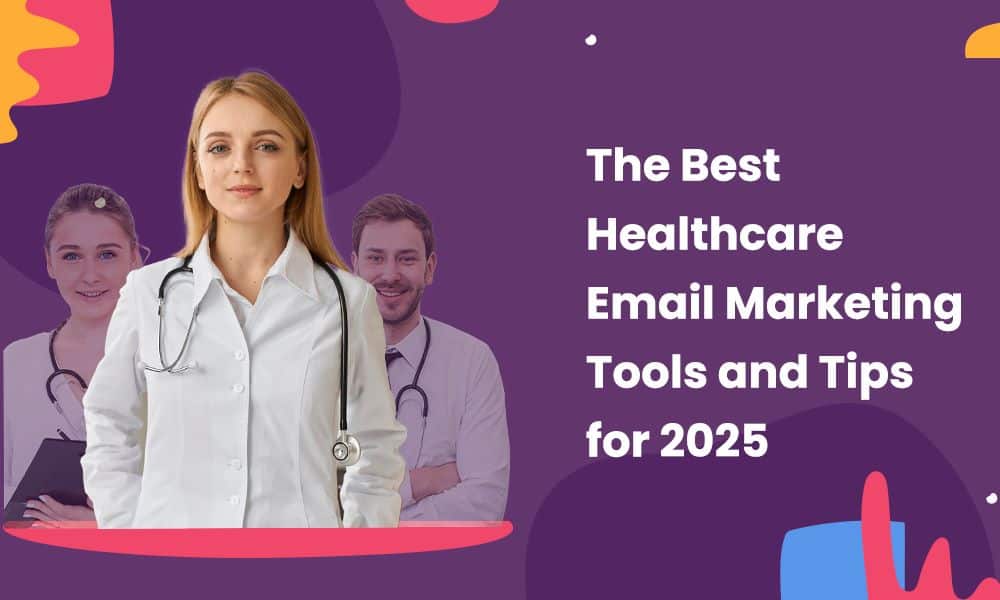Trust is most important in the healthcare industry, but keeping your patients healthy isn’t enough to maintain relationships. Mastering healthcare can be your golden ticket to lasting relationships and expanding your practice.
Healthcare email marketing strategy is not just about sending out monthly newsletters. It must create an empathetic, informative, and respectful sense of the patient’s journey. Emails sent to your patients must balance professionalism and personalization while ensuring compliance alongside engagement.
In this blog post, we aim to lay bare the best healthcare email marketing tools and strategies to help healthcare practitioners and professionals market their services efficiently.
Let’s get started.
Table of Contents
Understanding the Landscape of Healthcare Email Marketing
Email marketing for healthcare institutions is a powerful tool for communication, with the highest open rate among all industries at 46.67%. While you may see your patients a handful of times over the year, healthcare email marketing lets you:
- Offering personalized communication
- Maintaining trust and credibility
- Delivering marketing campaign in a non-invasive manner
Communication needs and expectations of this industry’s target audience are quite different from the others. Patients seek more than just medical information; they seek reassurance, guidance, and a sense of connection with their healthcare providers.
This can be met by personalizing content based on individual health journeys along with updates on new services or changes in practice
Email marketers must be careful with what information they use to tailor interactions, as healthcare email marketing must adhere to compliance standards. Health Insurance Portability and Accountability Act (HIPAA) compliance is most important when dealing with patient data and sending health-related emails.
HIPAA measures are to safeguard the confidentiality of patient’s health information and other sensitive data, such as:
- Name and contact data
- Social Security Number (SSN)
- Medical history
- Financial data
- Facial data
HIPAA regulations have strict privacy and compliance requirements to avoid data breaches and dodge hefty fines for exposing patient data. To maintain these standards, healthcare providers must:
- Get patients’ express permission to receive emails
- Use email systems compatible with HIPAA
- Automate in compliance with HIPAA
- Enable end-to-end data encryption
What to remember:
- Personalize and build trust: Tailor email content to individual health journeys and maintain trust.
- Strict HIPAA compliance: Ensure all healthcare email marketing adheres to HIPAA standards. Protect patient information with secure, compliant email systems and obtain the necessary consent.
Setting Up Your Healthcare Email Marketing Campaign
The foundation of a successful healthcare email marketing campaign is its email list. However, building an email list with HIPAA compliance in mind means you must acquire email addresses with consent from your patients– either during their visits or through online platforms.
Here’s a good thing, though: ethical practices in acquiring patients’ email addresses not only comply with legal standards but also build trust with your patients.
Building a contact list for healthcare email marketing
Here’s how you can ethically collect your patients’ email addresses to build a contact list:
Opt-in form during their appointments: During appointments, patients can opt in by including a section in their paperwork, whether digital or paper-based. Here’s an example:

Through online platforms: Add embedded opt-in forms, sign-up pop-ups, or landing pages on your blog or through digital advertising to get new subscribers. Here’s an example from Michigan Dental:
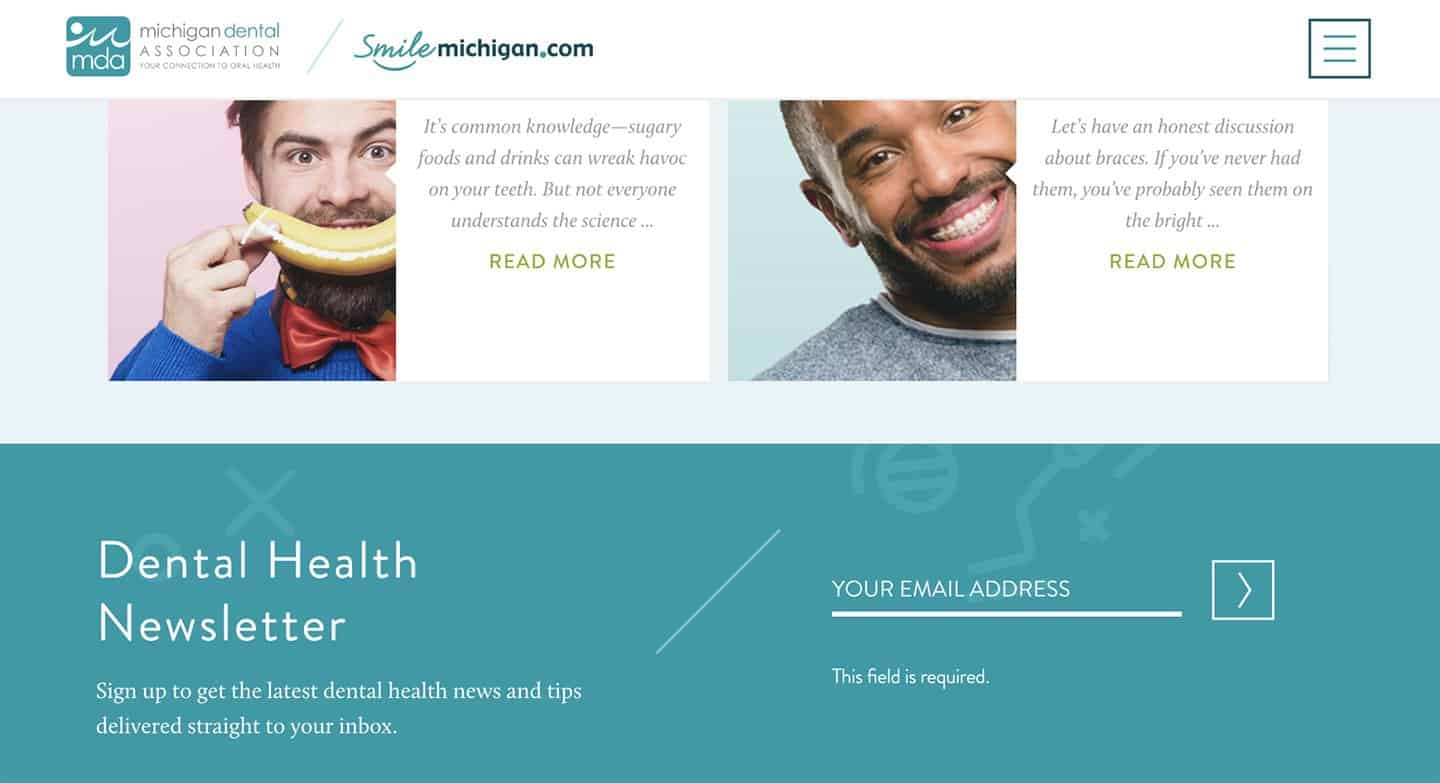
Segmenting customers for personalized content in healthcare marketing
Customer segmentation is the next step after collecting email addresses. Dividing your mailing list into different categories based on contact attributes allows you to deliver more targeted emails. This ensures that you treat two patients equally.
For example, you may establish a cohort of cardiology patients to send emails to maintain a healthy heart. This is far more efficient than blasting your whole list with generic emails they might not care about.
Choosing the right marketing platform for healthcare email marketing
Given the complexity of healthcare email marketing, choosing a marketing platform with care is imperative. It should offer features that cater specifically to the healthcare industry’s needs, such as:
- A HIPAA-compliant CRM
- Easy-to-use segmentation tools
- Effective automation capabilities to build a contact list
You may also automate segmentation by creating a registration page where your subscribers may choose their preferences. For instance, allow subscribers to choose your messages’ frequency and subject matter.
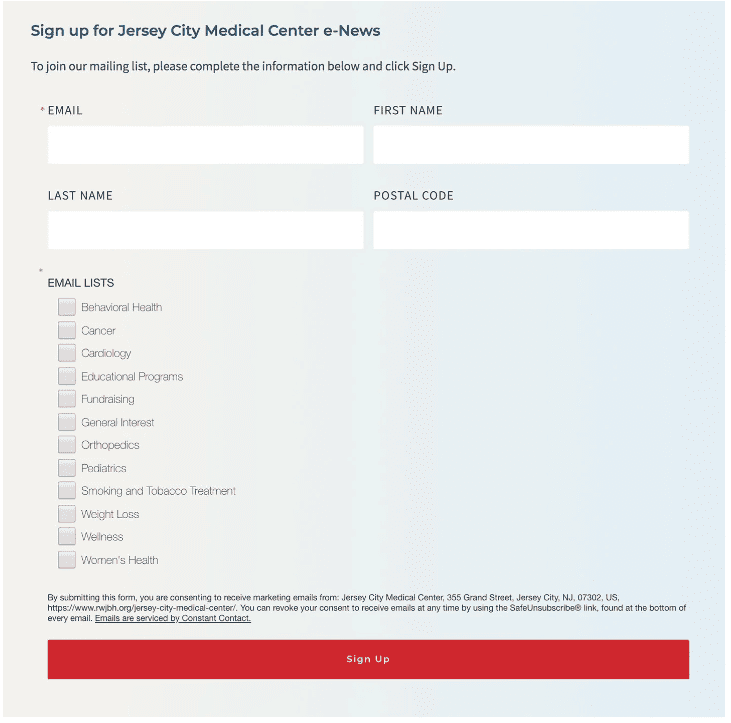
An efficient CRM places subscribers into the relevant group once they submit the form. With this feature, you may build topic-specific health newsletters and automate sending them to the right group of contact lists.
EngageBay offers a comprehensive CRM that offers everything we mentioned above and more. Check EngageBay’s email marketing system to grow your business and streamline contact management.
What to remember:
- Consent is key: Always obtain patient consent for emails to ensure HIPAA compliance.
- Segment for relevance: Segment contact list based on shared data and interest in sending personalized emails based on patient needs.
- Platform matters: Choose an email platform like EngageBay, designed for healthcare’s unique requirements.
Read also: CRM In Healthcare To Enhance Patient Satisfaction
Content Creation for Healthcare Email Marketing
Now that we’ve discussed how to build a contact list and segment it for sending tailored communication, let’s talk about content marketing strategy and what type of content you can include.
7 types of healthcare emails to send
You can include various types of content in your healthcare email marketing. It’s essential to ensure your emails strike a balance between promotional and informative content.
Here are a few types of popular email content:
1. Thank you for subscribing/Welcome email
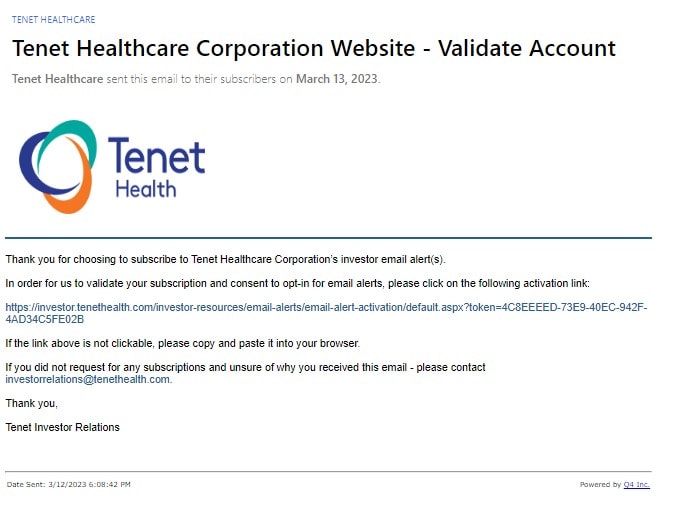
2. Verification emails
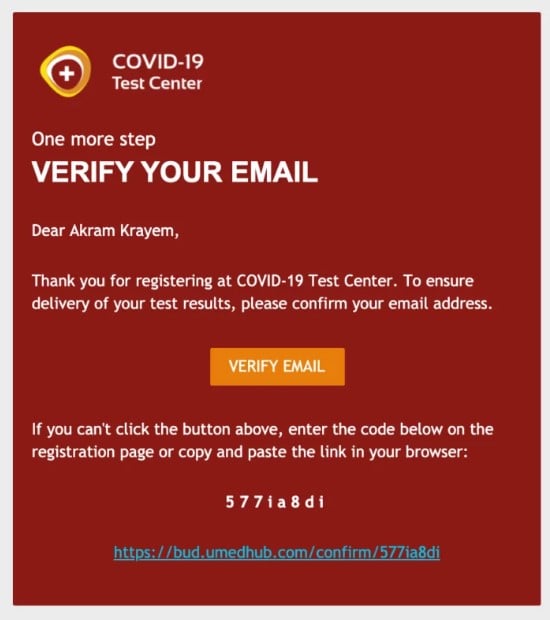
3. Appointment confirmation emails
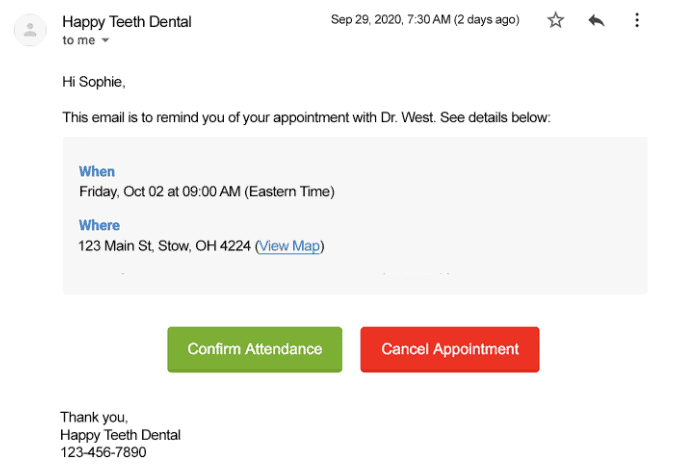
4. Educational emails
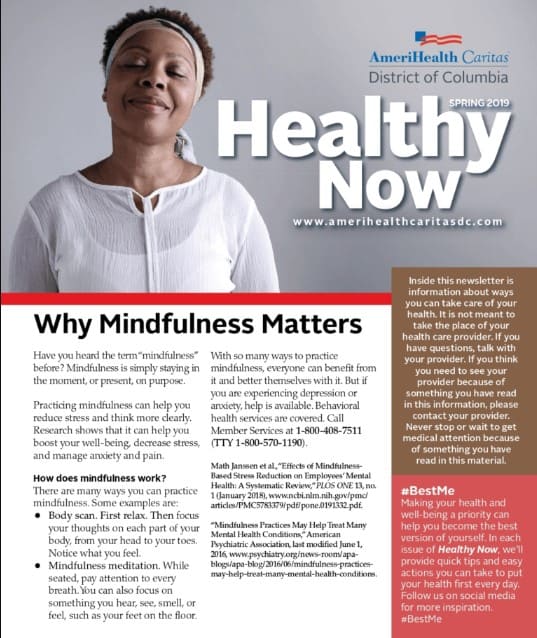
5. ‘Connect with us’ emails
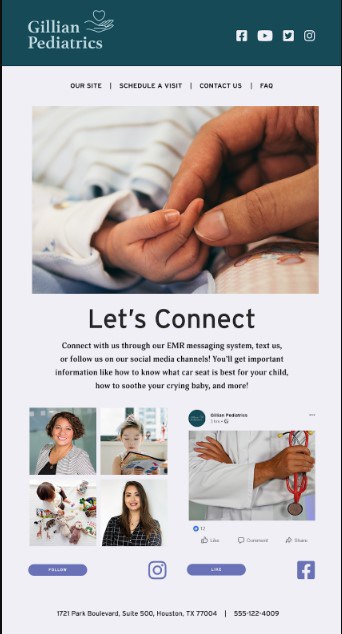
6. Birthday or anniversary emails
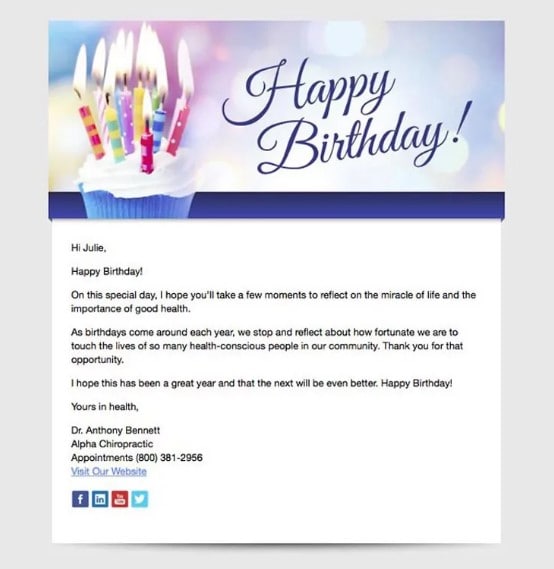
7. Promotional emails
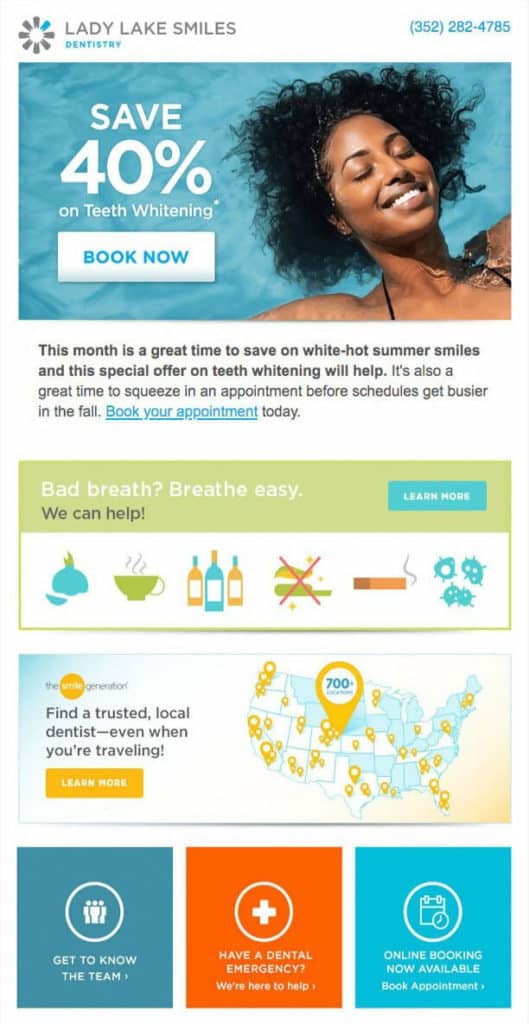
How can you make your email content engaging in healthcare marketing?
If you want your email recipients to engage with your newsletters, the key is personalization. You can personalize email content in the following way:
- Address the recipient by their first name
- Focus on the shared preferences and interests of segments
- Customize email content according to recipient preferences and opt-in source
Keeping a check on personalization and the right segmentation is of the essence to make your email content engaging and interesting. For example, sending emails about losing weight to a list of contacts that opted-in for a blog post titled “6 ways to gain healthy weight” would be illogical.
In addition to personalized content, don’t neglect the importance of catchy subject lines and a strong CTA in driving engagement.
- Subject lines are the first opportunity to grab the recipient’s attention. An engaging subject line that intrigues the reader can boost your open rates when done right. Here are a few tips:
-
- Keep it short, snappy, and straightforward
- You may create urgency with a discount
- Ask a question that creates curiosity
- Avoid manipulative or exaggerated subject lines to catch the attention
-
- A call-to-action (CTA) appears at the end of your email to guide the reader into taking action. These buttons serve as visually appealing links that intend to captivate readers and encourage them to interact with your content. This can be anything, such as:
-
- Schedule a meeting
- Read a related article
- Check out a landing page
- Make an outstanding payment
-
What to remember:
- Diverse content types: Incorporate a mix of promotional and informative emails, such as appointment confirmations, educational content, and birthday wishes, to maintain engagement and value.
- Personalization is crucial: Tailor email content by addressing recipients by name and customizing messages based on their interests and opt-in preferences to increase relevance and engagement.
- Engagement tricks: Utilize catchy subject lines to grab attention and clear CTAs to guide readers towards desired actions, enhancing interaction with your content.
Read also: How To Attract Modern Patients — 11 Effective Healthcare Marketing Ideas
Designing Emails for Maximum Impact
Once you’ve developed a healthcare email marketing content strategy, it’s time to work on the design. There are two most important components of an email design:
- The layout
- The visuals
The layout
Though the content of the email must be useful and relevant, getting people to read it should be your first concern. A good layout ensures your content is readable. Here are three guidelines to keep in mind when you plan your layout:
- Avoid having readers scroll side to side by keeping the width of your email or newsletter to 600 pixels.
- Enhance its scannability by dividing your main ideas into sections using descriptive headings and bullet points.
- The hierarchy should be maintained by placing the headline at the top, which summarizes the primary message; the body content follows, which gives the supporting arguments; and the call to action concludes.
The visuals
When designing an email, visuals are as important as a well-organized layout. Not only may images make an email easier to read by breaking up the text, but they can also emphasize key points. You may use:
- Images
- Animated GIFs
- Videos
- Infographic
- Background patterns
Keep these two things in mind to nail the visual aspect of your emails:
- Choose the color wisely: Consider the impact that color may have in evoking emotions.

- Choose the appropriate imagery: Make sure your chosen visuals go well with the text. The reader anticipates learning something particular based on the visual.
Read also: A Quick Guide on Insurance Email Marketing
Mobile-first design
These days, being mobile-friendly isn’t enough; being mobile-first is essential for successful email marketing. Emailmonday reports that 61.9% of all emails get opened on mobile devices. As important as it is to have a responsive email design, being mobile-first is about more than just an optimized email.
Always make sure to:
- Align text, image, CTAs, and all other elements to device size
- Mobile-optimize every page linked to the email campaign
- Consider multi-device behavior, such as using a phone to browse and a PC to take action
- Use all the smartphone features to collect data, such as health tracking and location services
Here’s how a responsive email should look:
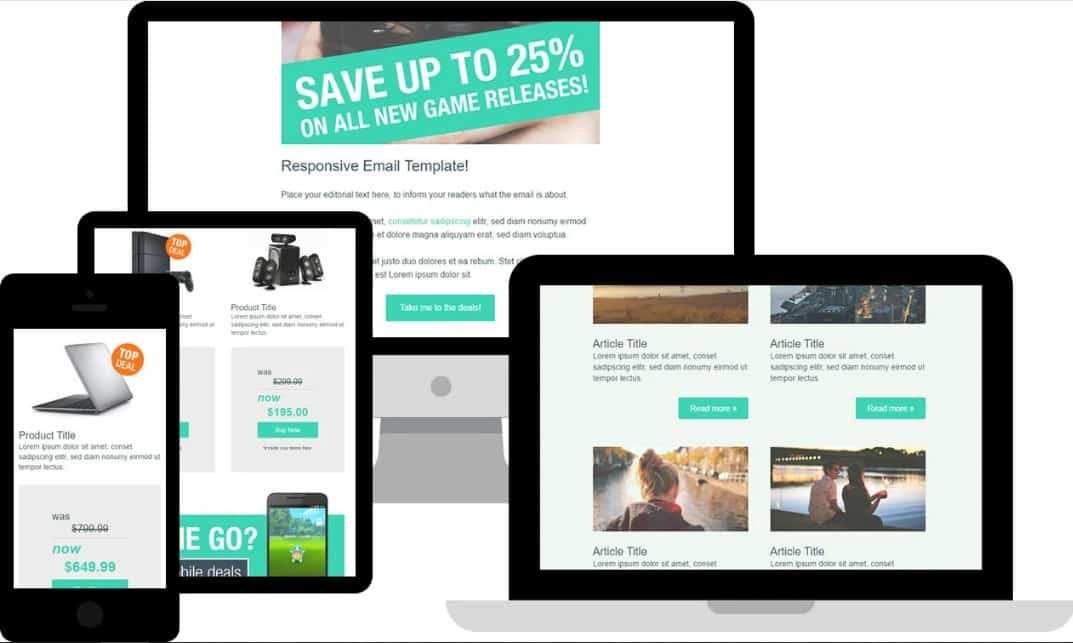
What to remember:
- Optimize layout for readability: Ensure your emails are easy to read with a layout that doesn’t require side-scrolling, uses descriptive headings and bullet points for better scannability, and follows a logical structure from headline through body to CTA.
- Incorporate strategic visuals: Incorporate visuals like images, GIFs, and videos thoughtfully to complement your message and enhance readability, paying attention to color psychology and image relevance.
- Mobile-first approach: Design emails with a mobile-first mindset, optimizing for mobile viewing and interaction, considering the high volume of emails opened on mobile devices.
Read also: CRM In Healthcare To Enhance Patient Satisfaction
Time and Frequency of Sending Healthcare Emails
Time is of the essence in both life and email marketing. It doesn’t matter how captivating your emails are if they don’t reach your present and prospective patients at the right moment. How do you determine the best time to send emails?
Simple answer – trial and error.
It’s important to focus on optimizing based on open rates rather than relying on some one-size-fits-all answer. Here are some tips to determine the best time and frequency:
- Monitor engagement: When deciding when and how often to send an email, keeping an eye on engagement metrics like opens, clicks, and unsubscribes is important. If a specific time shows more engagement, note that. If engagement is low, you don’t want to send too many emails. Start easy and build as engagement increases.
- Employ A/B testing: By experimenting with various times and frequencies, see what works best for your audience segments. With this strategy, you may measure the influence of small adjustments on the open rate, clickthrough rate, and conversion rate of your email marketing campaigns.
- Consider the context of communication: While healthy people may prefer less frequent communication, patients who have just been diagnosed or received treatment may want more regular updates. Email frequency and content tailored to the patient’s condition and demands may boost engagement and open rates.
- Balance frequency based on purpose: Differentiate informative and actionable messaging. Informational emails, like health advice or updates, should be sent as periodic newsletters. On the other hand, action-driven emails, like survey completion or appointment reminders, can be event-triggered.
- Set a schedule: You want your customers to anticipate your email. Consistent but spaced-out emailing ensures that your patients will see your messages often without overwhelming them. Set a regular schedule to send out your emails; once every two weeks or once a month is a good standard.
What to remember:
- Analyze engagement data: Review how you engage patients with your emails (open rates, click-throughs) to understand their preferences and adjust timing accordingly.
- Experiment with timing: Use A/B testing to experiment with different send times and days, then adjust based on which options yield higher engagement rates.
- Personalize send frequency: Consider the patient’s context (e.g., treatment phase) and content type (informational vs. action-oriented) to customize the frequency and ensure timely and relevant emails.
Read also: Beyond the Basics — 13 Hospital Advertisement Ideas to Elevate Your Marketing
Measuring the Success of Your Healthcare Email Marketing Campaigns
Healthcare email marketing can offer great results. In fact, data shows it offers a great return of $42 for every dollar spent. The key to achieving that ROI is careful planning and, most crucially, a commitment to tracking the performance of your email marketing campaigns.
What metrics should you be tracking? Below, we’ve listed the five most important key performance indicators (KPIs).
Open rate
Open rate is the percentage of subscribers who open your email. Keeping an eye on this metric over time will demonstrate your subscribers’ anticipation of your emails.
If the trends show improvement, your content is doing well amongst your target audience.
If the trend declines, you must adjust your healthcare email marketing content strategy.
Click-through rate (CTR)
Click-through rate (CTR) measures the proportion of email recipients who click on a link inside an email marketing campaign. The fact that subscribers were interested enough to take a desired action after opening the email is evidence of good engagement.
The average CTR in healthcare email marketing is 2.68%. A good and improving CTR over time demonstrates:
- Interest in the brand as a whole or email engagement
- The success of content strategy
- Well placement of links
- A good count of links
- The right balance of a variety of media
Click-to-open rate (CTOR)
This metric is a combination of the above two metrics. It shows how many subscribers open your emails and how many take action. It measures how many customers are really interested in using your healthcare system or practice, making it a great indicator of the quality of service you can provide.
The Mailerlite reports that the median CTOR for the medical, dental, and healthcare industries is 5.74%. Here’s what you can do to nail this KPI:
- Make links obvious and clickable, particularly on mobile devices
- Use multiple CTAs placed strategically
- Avoid clickbait subject lines and ensure your email content fits your subject line
- Segment and provide audience-relevant content
Unsubscribe rate
The unsubscribe rate is the number of people who choose to stop receiving your emails. Healthcare email marketing has a considerably high unsubscribe rate of 0.33%. This is why you want to focus on delivering relevant, personalized, and engaging content in your campaigns.
Why you should track this metric? It can tell which healthcare email marketing campaigns are successful and which aren’t.
If many people cancel subscriptions, your email will not get delivered. As a result, your domain will acquire a bad image amongst email service providers like Gmail and Yahoo. It can automatically land your emails in spam folders!
Bounce rate
The bounce rate is the number of subscribers that didn’t get the email because the mail server sent it back. Email bounces can be broken down into two groups:
- Hard bounces: These are permanently undeliverable since you may have got the email address or domain name wrong
- Soft bounces: These are fixable issues since they may occur when the recipient email is full, or the files attached in the email are too large
It can be a waste time, money, and resources when emails don’t go through. You may reduce the bounce rate by:
- Check your emails for triggers of spam filters.
- Keep patients’ email addresses updated with changes for old patients, physicians, etc.
- Remove any incorrect email addresses that may take up space in your database.
Keep track of campaign results with analytics to ensure effective healthcare marketing communications. Many CRM systems, such as EngageBay, offer automated A/B testing. It tests subject lines by sampling a part of your contact list to get subject line A and another with subject line B. This helps you quickly determine a winning subject line to send the rest of your list.
With this data, you may optimize the current campaign and use it as a foundation for future campaigns and testing.
What to remember:
- Monitor key metrics: Focus on tracking open rates, click-through rates (CTR), and click-to-open rates (CTOR) to gauge the effectiveness of healthcare email campaigns and understand subscriber engagement and content relevance.
- Analyze and adjust: Use the insights from these metrics to refine your content strategy, ensuring it aligns with subscriber interests and behaviors. This may involve adjusting email content, design, and call-to-actions (CTAs) to improve performance.
Read also: Say Aaah … 11 Jaw-dropping Dental Marketing Ideas
Advanced Techniques for Enhanced Engagement in Healthcare Email Marketing
What happens when you use healthcare email marketing to boost your other digital marketing efforts?
Your overall healthcare marketing strategy benefits and shows better results. Here are three advanced techniques to boost your audience engagement:
Retarget your contacts on other channels
Adding your contact list is a feature available on every major social networking site. It will let you discover the social media handles of those familiar with your brand and who have shown their approval by subscribing to your email list.
This becomes a powerful way to build brand loyalty and increase purchases with retargeted ads.
After you’ve uploaded the contact list, use social media ads to provide personalized offers to subscribers. Maintaining constant contact and engaging with people on your email list on social media channels will:
- Enhance your brand’s relationship with them
- Give you additional information about their needs and demands
Monitoring people’s social media feeds on your email list will help create products and blog entries that address their problems.
Check how Hubspot integrated social media and their email marketing by simply finding a subscriber over Twitter:

Use customer testimonials to build credibility
Customer testimonials are a great way to show how satisfied a client is with the healthcare service they receive. Email testimonials are a great way to get the word out from your most dedicated patients.
You may ask clients to share their experiences with your practice with online reviews. Share them with your email list to build the trust of present and future customers in your business and service.
The following shows an example of a couple’s account of an IVF-related ethical problem. Furthermore, Tennessee Reproductive Medicine (TRM) included a customer testimonial at the email’s conclusion.
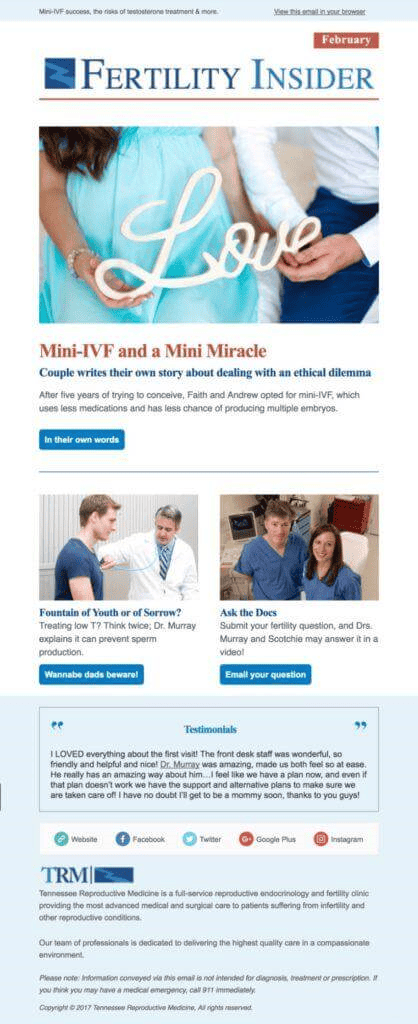
Leverage automation for healthcare email marketing
If you want to save time and effort while increasing engagement, use automation technologies with your healthcare email marketing campaigns. Automated emails let you tailor your communications to each customer journey stage. For example, you may use email automation to:
- Send a welcome email to a new subscriber, followed by a sequence of emails for onboarding.
- Get your patients’ scheduled appointments confirmed.
- Make sure to bring all necessary paperwork to the appointment.
- Check-in with patients’ health status.
- Remind patients to have their medicines refilled.
Here’s an automated reminder from Fullscript to refill medicines:

From the time prospective patients hit your website through their visit to your healthcare facility, every step of the process may be automated. There are several advantages to automating your healthcare email marketing process:
- You reduce your chances of forgetting to send an email on time.
- Due to your diligent follow-up on patient bookings, you never lose track of a patient.
- Prioritize efficiency for you and your team.
- Engage potential patients and establish a foundation of trust.
What to remember:
- Cross-channel retargeting: Use your email list to retarget on social media to increase brand loyalty and gain insights into subscriber preferences, making your digital marketing more personalized and effective.
- Utilize testimonials: Embed patient testimonials in emails to enhance credibility and trust, showcasing the positive experience of your services on patients’ lives.
- Implement automation: Leverage automation for timely patient communications, such as appointment reminders and medication refills, to improve efficiency and patient engagement.
Read also: 13 Best CRM for Higher Education For 2x Results
Conclusion
As we wrap up our comprehensive guide on healthcare email marketing strategy, it’s clear that the journey toward effective patient engagement and growth through email marketing is both an art and a science. Healthcare providers can create a powerful and personal connection with their patients by prioritizing empathy, informative content, and respect for their journey.
Adhering to HIPAA compliance while delivering personalized and relevant content is not just a best practice; building trust and maintaining patient information’s confidentiality and safety is necessary.
Remember, the success of your healthcare email marketing strategy hinges on understanding your audience. You must send messages that resonate with them and continuously optimize based on engagement metrics.
Whether you’re starting to build your email list, segmenting your audience for targeted communication, or designing emails for maximum impact, each step is crucial in developing a strong connection with your patients.
Looking for an all-in-one CRM to aid you throughout? Start with EngageBay today and experience the difference in patient engagement and healthcare practice growth.
EngageBay is an all-in-one marketing, sales, and customer support software for small businesses, startups, and solopreneurs. You get email marketing, marketing automation, landing pages and email templates, 360-degree customer views, and more.
Sign up for free with EngageBay or book a demo with our experts.
Frequently Asked Questions (FAQ)
1. Why is email marketing important for healthcare providers?
Email marketing allows healthcare organizations to maintain a continuous, personalized dialogue with their patients. It’s crucial for patient engagement, retention, and education while adhering to HIPAA compliance to provide a platform to share:
- Valuable health tips
- Office updates
- Service offerings
2. How can I ensure my healthcare email marketing is HIPAA compliant?
To ensure HIPAA compliance, use secure email platforms that:
- Offer end-to-end encryption
- Obtain explicit consent from patients before sending emails
- Avoid sharing sensitive health information without authorization
- Always provide a clear option for recipients to opt out of future communications
3. What content should be included in healthcare emails?
Healthcare emails should balance informative and marketing emails, including:
- Health tips
- Appointment reminders
- Service updates
- Personalized patient education
The key is to offer value that resonates with patients’ needs and interests.
